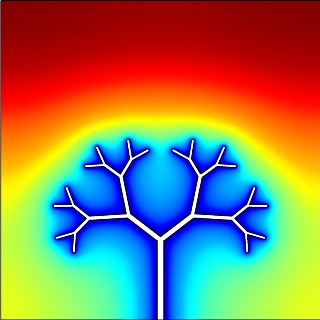Jun 11 2015
Researchers have discovered that when materials are melted along a tree-shaped pattern of lines, the efficiency of phase change energy storage systems can be improved significantly.
Materials tend to melt quickly when the lines of heat propagate across the cold material, just like a tree’s branches, and the speed of melting can be gradually raised by enabling the tree design to evolve freely over time. This latest finding may pave the way for improving the performance of phase change energy storage systems. The study results have been reported in AIP Publishing’s Journal of Applied Physics.
 Tree-shaped heat invasion, for energy storage CREDIT: Adrian Bejan/Duke University
Tree-shaped heat invasion, for energy storage CREDIT: Adrian Bejan/Duke University
Phase change energy storage systems typically store heat by melting salt, wax and other materials. They could help ensure a smooth flow of energy from sun, wind and other renewable sources. Branching patterns, similar to the ones studied in the melting of materials by the researchers, often occur in nature, right from spreading river deltas through to treetop canopies. According to Adrian Bejan, who serves as a professor at Duke University in Durham, North Carolina, similar branching patterns can be seen across discrete systems, as the same fundamental physical law drives the evolutionary pattern.
Back in 1996, Bejan applied a new principle, which he dubbed as Constructal Law, to discover the mechanism behind these natural branching designs. According to this law, for trees, rivers and other flow systems to survive, they need to evolve over time to provide better and easier access to the currents flowing through them.
This means that a plant will readjust its branches so that nutrients and water can flow easily, and a river will change its direction as it flows into the sea to prevent any kind of obstructions induced by settling sediment. In the next 20 years, Bejan along with fellow researchers has demonstrated how the evolution of man-made and natural designs, spanning from airplanes to snowflakes, is elucidated by the Constructal Law.
"There is organization happening naturally all around us, and the Constructal Law is the physics principle that underpins it. What's left is to be wise and to rely on the principle to fast-forward the design of technology," said Bejan.
In the latest paper Bejan and other scientists from the Université de Toulouse in France and Duke University have applied the Constructal Law to boost the performance of the phase change energy storage systems. Such systems exploit the fact that when materials experience a phase change, such as freezing or melting, they store or produce excess amounts of thermal energy at a constant temperature.
Phase change energy storage systems can be employed in buildings to absorb and release heat during day and night, respectively, and can also be used in in solar power installations to stock large amounts of energy and in spacecraft to control the flow of heat. The research team observed that the overall speed of melting increased considerably by enabling the number, length, and branching angle of the "fingers" to freely evolve over time.
"The traditional architecture is to embed a heating and cooling coil in the phase change material, but our research shows that what happens naturally is also the best way to spread the heat into the volume: it is a dendritic structure, like a hand with many fingers," Bejan added.
According to Bejan, a faster melting rate ensures that thermal energy is successfully transmitted to the fixed amount of phase change material present in the system. Improving the transfer of heat to the phase change material becomes all the more critical if the system is utilized to stock energy in a vehicle where any amount of surplus weight would slow it down considerably.
"Imagine building a branching structure, with billions of tiny, tiny fingers touching at the tips. You'd say forget it!. The Constructal Law shows that natural systems are constantly evolving. Technology will follow the same path. You can imagine that the phase change technology of the day would have a fixed tree-shaped architecture, but it would be overtaken in the following years by even better architecture," Bejan said.
If the branching structures are more complex, the melting process would become even faster; however, there is a law of diminishing returns. At a certain point, the sequence of improvements would be eventually interrupted by a human designer due to the time and costs associated with additional complexity.